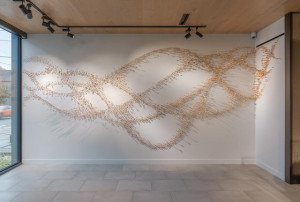
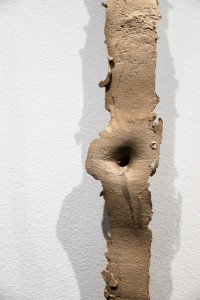
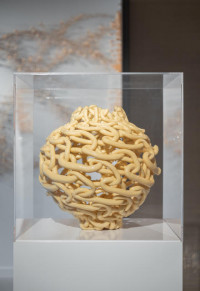
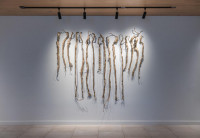
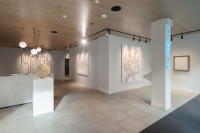
On Tuesday, Feb. 25, 2025, at 11.30 a.m. Joseph Gallivan interviews curator Sima Familant about Breathing Room, a show on now at the Lobby Gallery in Southeast Portland. Sima talks about the importance of white space or negative space in the paintings and sculptures she has chosen for this show, which include castings of a naked man, an MS Paint-style mouse drawing writ large, and a 3D-printed moon bowl. Familant also talks about the urge to escape the blitz of images and sounds that make up modern life and find stillness in these works of art.
Special note: I am looking for work as a writer/broadcaster right now.
Find me on LinkedIn and refer me to your friends who appreciate art or writing or both.
From the press release:
https://ellenbrowningbuilding.com/exhibition/breathing-room/
Breathing Room
The Lobby at Ellen Browning Building
2871 SE Division Street
Portland, OR 97202
Opening: Friday, October 18, 2024, 6-8 pm
Curated By Sima Familant
—
Artists included in the show:
Jeff Elrod, Naotaka Hiro, Kwangho Lee, Kwon Young-Woo, Ranjani Shettar, Tsai Yun-Ju
—
Artworks often enhance a space, but how can they do so without overwhelming it? Artists frequently use blank space or the color white to introduce a sense of freshness and subtlety, creating what might be seen as “a breath of fresh air.” When examining complex works, artists may leave areas intentionally blank or introduce white to balance out intensity. In sculpture, this can manifest as open spaces or gaps, allowing viewers to see through the object and form their own connections with the work. “Breathing. Room” seeks to evoke this pause. With the increasing noise in our lives, between the endless ringing of devices and the general hum of a crowded world, moments of pause have become rare luxuries—perhaps the most essential gift an artist can offer.
For her first exhibition in Portland, Ranjani Shettar presents her monumental wall installation, featuring hundreds of handmade lacquered wood elements crafted by women in an Indian village, one of the last places where this traditional shellacking process is still done by hand. Shettar’s work often explores industrialization, societal concerns, and the interaction between nature and modern life, expressed through her distinctive use of material. In Morning Song, the artwork in the exhibition, the wood pieces vary in angle and scale, flowing across the wall like a water current or a trail of stars. The shadows these pieces cast, though not listed as materials, are integral to the experience, raising the question: Is the space between the objects part of the artwork too? Perhaps the wood pieces are framing the empty wall….allowing the room to breathe.
Kwangho Lee’s Moon Jar offers a contemporary take on a traditional Chinese vessel, typically made of two joined shapes in pure white porcelain. Lee, however, utilizes 3D printing to marry modern materials with this traditional concept of purity, creating negative space within the vessel itself. Born in Korea and currently based in Seoul, Lee views his work as capturing “the instant moment of union,” a moment where the pause seems to reside.
Tsai Yun-Ju’s method is deeply rooted in her early training in gongbi, a traditional Chinese ink painting style, which she later adapted to oil painting during her studies at the Taipei National University of the Arts. Tsai describes her work as a meditation on conflicts and imagination, using brushstrokes to trace the flow of internal dialogues. In her painting for the exhibition, Tsai utilizes white space to break up the intensity of tangled lines, pausing a conversation between imagined protagonists and offering a momentary respite from an emotional state.
Kwon Young-Woo, a pioneer of the Korean Dansaekhwa movement, explored abstract expressionism using unconventional materials. In his later works, he experimented with the paper itself, creating subtle marks that require stillness and close observation to fully appreciate. His manipulation of the white paper introduces pauses within the work itself, allowing space for breath and contemplation.
Jeff Elrod, known for his abstract paintings based on digital drawings, was among the first artists to incorporate computers into the painting process. In the piece included in this exhibition, Elrod uses only white paint on canvas, with the canvas’ negative space playing an integral role in the image. The interaction between the white paint and the blank canvas creates calm interruptions amidst the painting’s underlying chaos.
Over the past two decades, Naotaka Hiro has explored whether we can ever truly know the parts of our bodies that we cannot see without a mirror or camera. In Sixteen Terminals, the work featured in this show, Hiro self-casts segments of his body, repeatedly working and reworking molds of himself. The resulting sculpture is an abstract representation that balances between the artist’s physical form and his internal self-image. Installed as separate elements on the wall, the space between each piece establishes a unique relationship among them, as if they are independent entities rather than fragments of the same body. Hiro describes this dynamic as “me versus me,” giving each part room to breathe….
Click Here for Press and Buzz about Breathing. Room
KBOO’s Fundraiser 2025
Where do you get your art content?
Just go to kboo.fm/give or text K-B-O-O to 44-321.
We need your money.
Art Focus on K-B-O-O Portland is the show where artists talk about their work.
KBOO is a volunteer-powered community platform. That means we are funded by you, the listener.
To hear previous episodes of Art Focus or any of our KBOO public affairs programming, just go to KBOO dot F-M or listen on iTunes, Google Play, or wherever you get your podcasts.
Joseph Gallivan has been a reporter since 1990. He has covered music for the London Independent, Technology for the New York Post, and arts and culture for the Portland Tribune and for Axios Portland. He is the author of two novels, "Oi, Ref!" and "England All Over" which are available lightly used.
- KBOO



